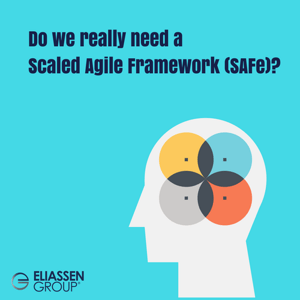SAFe® is exciting! It’s easy to see the possibilities that the Scaled Agile Framework® can bring to your enterprise as it blends numerous best practices, values and principles with a constantly evolving library of courseware.
If you’ve begun your SAFe® journey, you’ve likely trained many of your people, launched Agile Release Trains and seen some of the many benefits that Lean and Agile can bring to the Enterprise. Alternatively, you may also be seeing that improvements have plateaued, the cadence of delivery has slowed and people are beginning to disengage.
Late last year, I worked with a large enterprise client who was a fairly early SAFe® adopter; however, they were no longer experiencing increases in the benefits that they had seen when they first implemented the framework. We did an assessment, something we started referring to as a “SAFe® Health Check,” and found that the values, principles and practices that make up the foundation of Agile at scale did not make it into the sustaining phase of their change.
At the 2015 Scaled Agile Partner Summit, I was able to facilitate a session to discuss the concept of a SAFe® Health Check with some of the great SPC’s and SPCT’s. Together, we came up with a list of some of the common symptoms as well as a variety of treatment options.
Symptom - Low energy and lethargy: People are just going through the motions; energy and excitement is low; the right people have stopped showing up at meetings and ceremonies; the “old way” is exerting its gravitational pull.
Symptom - Something “smells” off: Deliverables are being missed; commitments aren’t being met; the metrics are perfect; agile ceremonies are being shorted; release planning attendees and/or time is cut; teams aren’t concerned about spillover from one sprint to another; there is a lack of valuable continuous improvement; singular focus on production without time for improvements and innovation; people aren’t laughing.
Symptom - “Un-SAFe” Living: The focus is on processes as opposed to values and principles; big room planning includes “key” individuals only; constant or frequent change and churn within ART’s and/or teams; “I need it now” becomes the norm (interruptions and emergencies are the norm); people aren’t finding value in particular ceremonies; features are broken down into requirements and assigned to teams; people are focused on their own team or deliverables as opposed to being invested in the program.
Symptom - Major Life Events: Original advocates, sponsors, change agents, etc. have moved on and “ownership of SAFe®” is not transferred and/or wanted.
Treatment Options - Triage: Have an “all hands” to reinforce the focus and vision of the ART, go back to the basics and do PI Planning as intended (work the program), bring in a coach to help teams see why they need to work together and use SAFe®, Agile and Lean values and principles.
Treatment Options - Continuing Care: Ongoing coaching and training; develop internal coaching skills (ICAgile, etc.); provide new people with the same level of training given to those when SAFe® was introduced; regularly do SAFe® self-assessments to aid in continuous improvement; respect WIP limits - especially at the Program and Portfolio level-define and run experiments to test and learn; use 360 degree surveys, candid feedback forums, etc. to understand the values and principles upon which decisions are made; reinforce or define true success measures at the ART and team level; introduce and/or encourage the use of spikes; review the value stream and address areas of waste or blockage.
Treatment Options - Alternative Medicine: Learn more about Change Management (ADKAR, etc.) and factor this into your journey; create a post in a SAFe® forum to discuss your specific issue(s).
Treatment Options - See a Specialist: Bring in a SAFe® partner to assist you in assessing and addressing your challenges.
As with any complex system, continued care and attention of your SAFe® Portfolios and ARTs will allow them to run optimally and continually evolve. Additionally, you may want to look at SAFe® 4.0 as this new version of the framework includes a strong foundational layer that can help prevent many of the symptoms discussed above.
Are you interested in learning more about SAFe® 4.0? Join Dean Leffingwell, the Creator of the Scaled Agile Framework and Phil Gardiner for a tour of SAFe® 4.0 for Lean Software and Systems Engineering.



